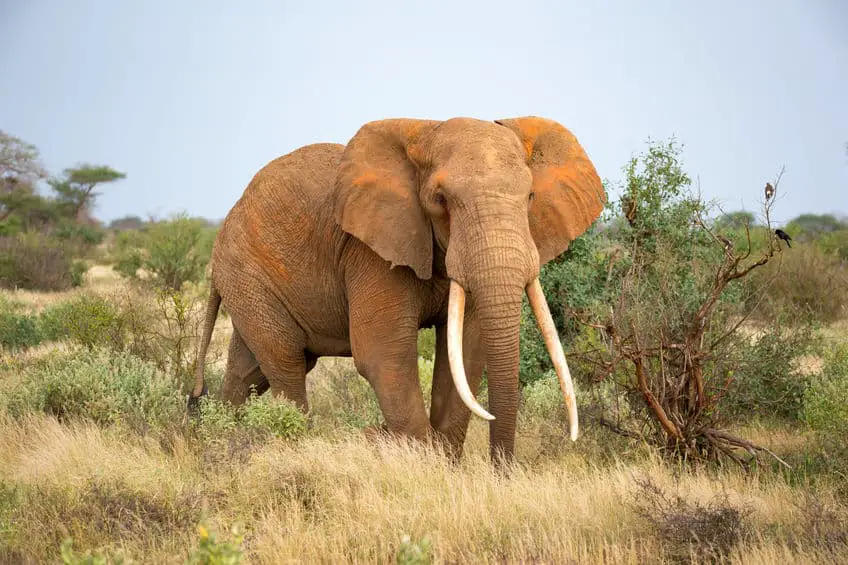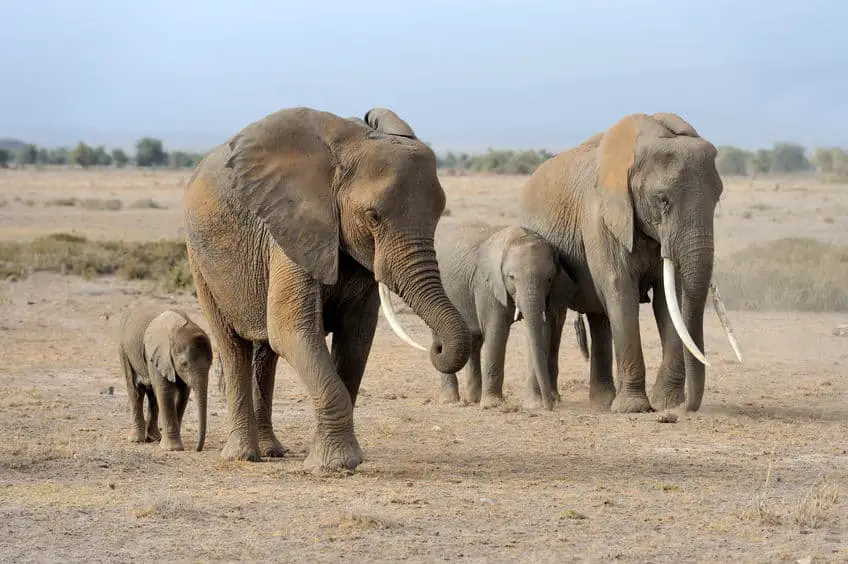
Elephants start growing their tusks when they are 6-12 months old. The tusks are incredibly practical tools that the elephants use for a number of different things. I find this very fascinating which is why I have written this post.
So what do elephants use their tusks for? Elephants use their tusks for debarking or marking trees, moving things around, and digging for water. Elephants also use their tusks for combat and self-defense where they sometimes attempt to impale attackers.
Tusks are one of the things that truly make elephants unique among other large African mammals and in this post I will talk about some of the things, the African giants use their tusks for as well as some other fascinating facts about elephants and what essentially are two overgrown (but extremely useful) teeth.
Elephants Tusks Are Practical Tools
Elephants are born without their tusks but it does not take long before they start growing. The tusks usually start appearing within the first year of the elephant’s life during which they are still considered babies (the “baby stage” usually lasts for 5-10 years).
Both male and female elephants grow tusks although the males’ tusks are usually larger than those of the females.
African elephants use their tusks for many things including stripping the bark off trees and branches as this provides an excellent source of nutrients.
When scraping the bark off the trees, the tusks are what the elephants use to actually get the bark free from the tree. Once the bark is off and the elephant gets it into the mouth, the elephant’s set of huge teeth inside the mouth (which can weigh up to almost 4 kilos each) takes over.
In addition to scraping bark off of trees, elephants’ tusks also serve as great digging tools and are used to dig for water.
Other than serving as excellent tools for getting water and nutrients, elephants also use their tusks to simply move things around and out of their way.
A fact that I found super interesting is that just like humans are left or right-handed, elephants are also left or right tusked. The dominant tusk is often slightly shorter than the other simply due to wear and tear as they use the dominant tusk the most.
Other than “just” being a couple of incredible (and conveniently placed) tools that African elephants can use for a number of practical things, the tusks can also serve a significantly more dramatic purpose. Let us take a look at that now.

Elephants Tusks Are the Worlds Largest Natural Weapon
Elephants are often perceived as being the calm giants that they usually are but when they feel threatened they can be extremely dangerous and even deadly.
The elephants’ tusks are not only useful for debarking trees, digging for water, and so on as written in the previous section but they can also serve as deadly weapons when the elephant feels threatened.
Sometimes elephants are in situations where they have to fight off attackers such as lions (or even humans). In these situations, the tusks can also be extremely useful and even deadly.
Elephants can sometimes try to impale and kill the attackers using their tusks.
Even when fighting with other elephants the tusks can be used as deadly weapons. Trying to tip over the opponent and using the tusks to impale the attacker’s head or body can be an effective (but not very pretty) strategy.
So there you have it. If you encounter wild African elephants, do not let their seemingly calm nature fool you because they can quickly get aggressive if they feel threatened and no matter how strong or brave you are, a fight with an elephant is not something you will stand a chance of winning. So keep a safe distance when you observe the mighty African giants.
How Large Can an Elephants Tusks Get?
Elephants tusks can vary greatly in size based on various conditions such as the age and gender of the elephant.
The tusks can reportedly grow up to as much as 17 cm per year and grow continuously throughout the elephant’s life.
The largest tusks can measure all the way up to 3 meters in length and the largest single elephant tusk ever measured came in at an unbelievable 328 cm and weighed in at an impressive 130 kg.
Male elephants are generally larger than female elephants and this is also true when it comes to the elephants’ tusks. For these reasons, the African elephants with the largest tusks are generally older male elephants.
Sometimes when you are out on a game drive, you can be lucky enough to see a giant elephant with tusks that seem almost unrealistically long and thick. This can be an incredible sight and if you’re lucky enough to see this then yes, chances are you have spotted an old male.
Speaking of old male elephants with large tusks. Have you heard about the Magnificent Seven?
The Magnificant Seven Elephants
The so-called Magnificent Seven elephants were seven giant male (bull) elephants that lived in the Kruger National Park of South Africa at various times between the years (approximately) 1926 and 2000.
The Magnificent Seven elephants were named so because of their impressive tusks consisting of more than 50 kg. of ivory.
The tusks of these giants are all (except one pair which was stolen and never found) exhibited in a small museum in Letaba Rest Camp in Kruger National Park of South Africa. I visited Letaba and this museum in the summer of 2018. This was truly an amazing (and highly recommendable) experience.
Here is a list of names of the Magnificent Seven elephants with a couple of interesting facts about each of them. The birth and death years are approximations and are not known for sure.
- Dzombo (1935-1983)
- Dzombo was the only one of the Magnificent Seven elephants that were killed by poachers. Dzombo’s life sadly ended in a hail of AK-47 bullets from poachers who wanted the ivory from the giant tusks.
- Dzombo’s left tusk was 255 cm long and weighed 55.8 kg. His right one was 237 cm long and weighed 56.8 kg.
- João (1939-2000)
- Like Dzombo, João was also attacked by poachers but this one luckily managed to escape and survive.
- João’s left tusk measured 271 cm in length and weighed 55 kg. His right tusk was 250 cm long and weighed 45 kg.
- Kambaku (1930-1985)
- The word Kambaku means “old bull elephant”.
- Kambaku’s left tusk measured 259 cm and weighed 63.2 kg. His right tusk was 265 cm long and weighed a massive 64 kg.
- Mafunyane (1926-1983)
- Probably the most characteristic thing about this bull elephant was the fact that he had a 10-cm-wide and 40-cm-deep gap in his skull which stretched into his nostril and therefore allowed him to breathe and consume rainwater through it. The origin of this gap is believed to be from a fight with another bull but is not known for sure.
- Both of Mafunyanes tusks were 251 cm long and weighed 55.1 kg.
- Ndlulamithi (1927-1985)
- The name means “higher than the trees” and comes from the elephant being taller than most others at 340-345 cm at the shoulders.
- His left tusk was an impressive 287 cm and 64.6 kg and his right was 273 cm long and weighed 57.2 kg.
- Shawu (1926-1986)
- Shawu was also one of the largest of the Magnificent Seven, measuring 340 cm at the shoulders.
- His tusks were the longest on record in South Africa at an incredible 317 cm (left) and 305 cm (right) in length, weighing 52.6 and 50.8 kg. respectively.
- Shingwedzi (1934-1981)
- Named after the river where he spent most of his time during the last years of his life, Shingwedzi was known as a pleasant and peaceful elephant.
- His left tusk measured 207 cm in length and weighed 47.2 kg and his right tusk was 264 cm long and weighed 58.1 kg. The reason for the significant difference in size is that he used his left tusk more frequently as I wrote about in an earlier section.
As you can see, there is a great variety in the size of the tusks and elephants can use them for several different things. What a fascinating animal!
